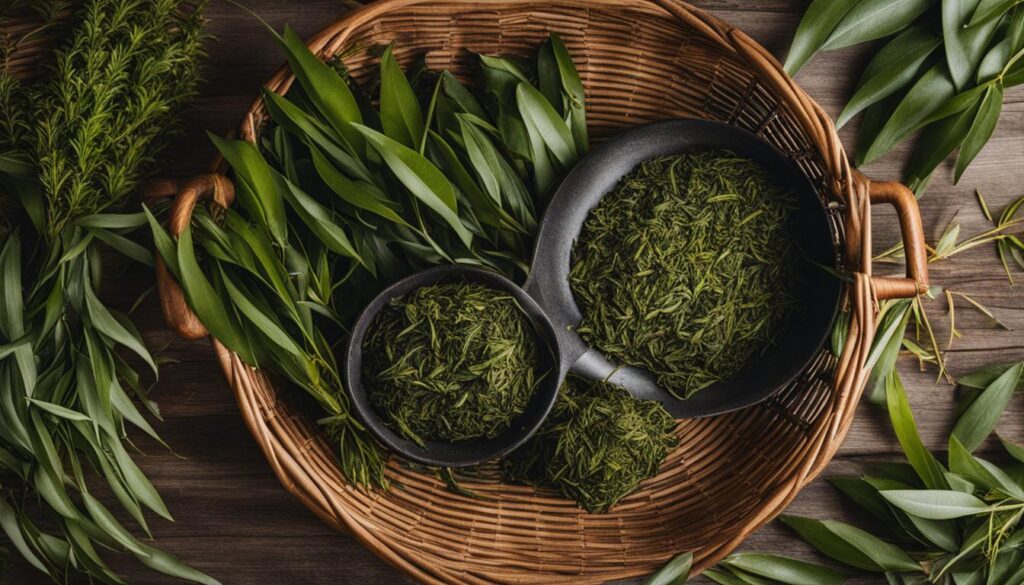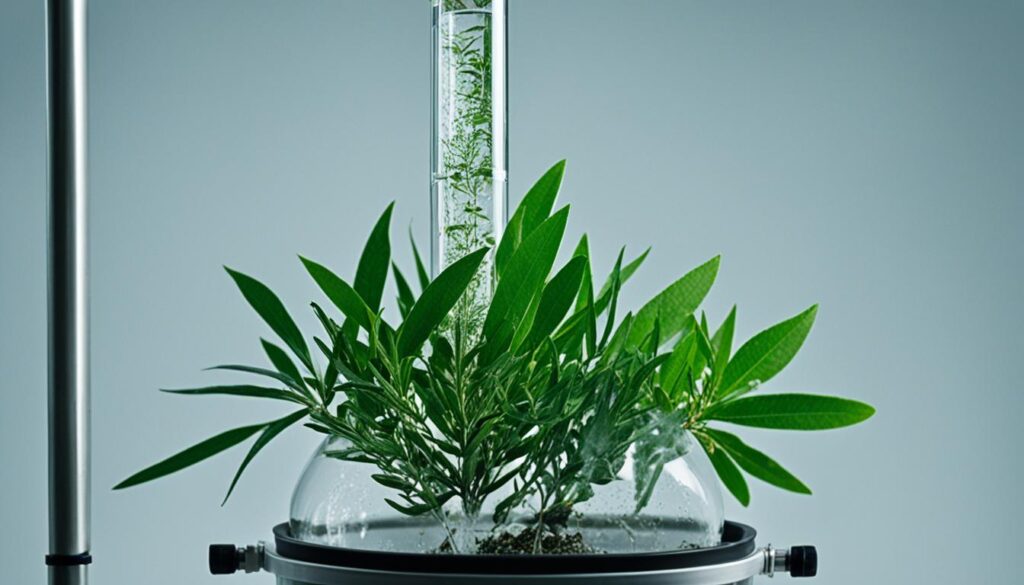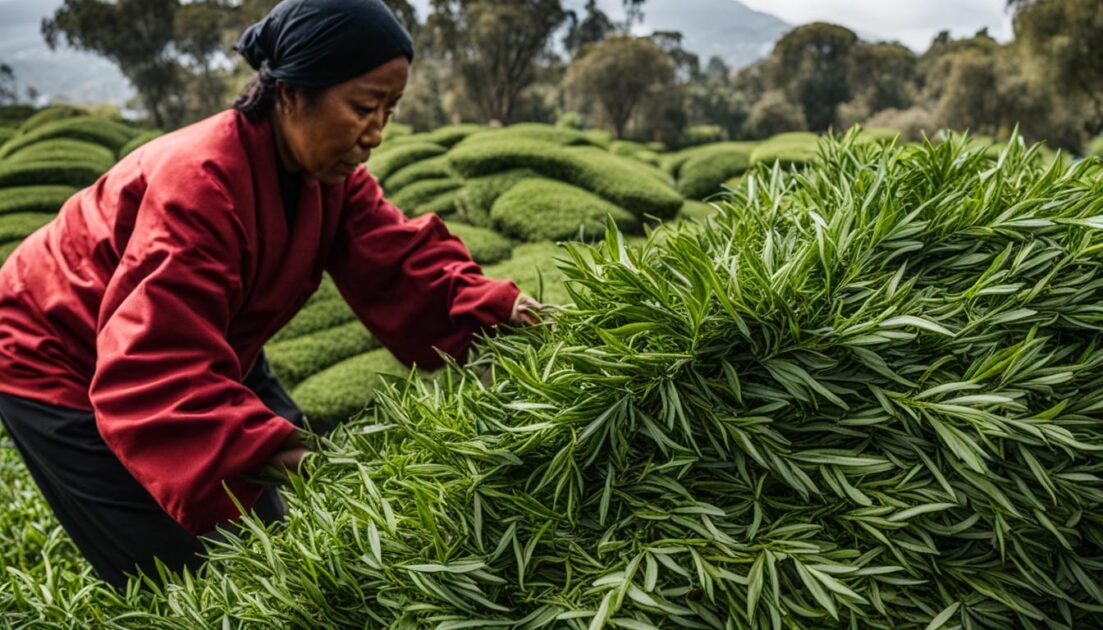Welcome to my DIY guide on how to make tea tree oil at home. Tea tree oil is a versatile and beneficial essential oil that has become incredibly popular for its various uses. By following this step-by-step guide, you can learn how to extract and produce your own high-quality tea tree oil right in the comfort of your own home.
Why make your own tea tree oil? Well, by DIYing your tea tree oil, you have control over the entire process, ensuring the purity and quality of the final product. Plus, it can be a fun and rewarding experience to create your own homemade remedies and products.
Key Takeaways:
- Tea tree oil is a versatile essential oil with numerous benefits.
- Making your own tea tree oil allows you to have control over the quality and purity of the product.
- Tea tree oil can be used to treat various skin and hair conditions, as well as for household purposes.
- Obtaining tea tree leaves and the necessary supplies is essential for home tea tree oil production.
- Ensure safety precautions and dilution when handling tea tree oil for personal use.
Understanding Tea Tree Oil and Its Uses
Tea tree oil, derived from the leaves of the tea tree plant, Melaleuca alternifolia, is a versatile essential oil known for its numerous benefits. Packed with antimicrobial, antibacterial, antifungal, antiviral, and anti-inflammatory properties, tea tree oil has become a popular choice for various applications.
One of the key uses of tea tree oil is in skincare. Its natural properties make it effective in treating acne, cuts and scrapes, athlete’s foot, nail fungus, psoriasis, and dandruff. The oil helps to cleanse and soothe the skin, alleviating various skin conditions and promoting overall skin health.
Not only is tea tree oil beneficial for the skin, but it also has household applications. Its antifungal and antibacterial properties make it an excellent all-purpose cleaner. By mixing tea tree oil with water, you can create a natural and effective cleaning solution for surfaces in your home.
Furthermore, tea tree oil can serve as an insect repellent. To create a homemade insect repellent, simply mix tea tree oil with water and spray it on your skin or in areas where insects are present. This natural repellent can help keep pesky bugs at bay while avoiding chemical-based repellents.
Overall, tea tree oil’s uses are vast, ranging from skincare to household cleaning and insect repellent. Its natural properties make it a popular choice for those seeking alternative remedies and solutions.
Common Uses of Tea Tree Oil
| Skin and Hair Care | Household Cleaning | Insect Repellent |
|---|---|---|
| Acne | Surface cleaning | Repelling insects |
| Cuts and scrapes | Disinfecting | |
| Athlete’s foot | ||
| Nail fungus | ||
| Psoriasis | ||
| Dandruff |
When using tea tree oil, it’s important to remember that it should be diluted before applying to the skin, as it is highly concentrated. Dilute it with a carrier oil, such as olive oil or coconut oil, to reduce the risk of skin irritation.
From its valuable properties in skincare to its versatility in household applications, tea tree oil offers a natural and effective solution for various needs.
Obtaining Tea Tree Leaves and Supplies
To make tea tree oil at home, you will need tea tree leaves. These can be obtained by purchasing them or by growing your own tea tree plant, Melaleuca alternifolia, if you live in a suitable climate. Additionally, you will need a small distillation set, which can be purchased online or rented from a chemistry lab. Other supplies include gloves, safety goggles, water, boiling chips or stones, and a dark tinted dropper bottle for storing the tea tree oil.
When sourcing tea tree leaves, ensure they are fresh and free from any damage or contaminants. If purchasing, look for reputable suppliers who prioritize quality. If growing your own tea tree plant, consider the necessary growing conditions such as sunlight, soil type, and watering needs.

The distillation set is an essential tool for the tea tree oil production process. It consists of a boiling container, a condenser, and a collection container connected through tubes. The boiling container holds water and tea tree leaves, while the condenser converts steam into liquid, allowing the separation of tea tree oil from the water. The collection container collects the extracted tea tree oil.
Wearing gloves and safety goggles is crucial throughout the tea tree oil production process to protect yourself from potential hazards. Gloves safeguard your skin from direct contact with concentrated tea tree oil, which may cause skin irritation. Safety goggles prevent any accidental splashes or contact with your eyes.
Water is a fundamental component in the distillation process. It acts as a medium for extracting the essential oil from the tea tree leaves. Boiling chips or stones should be added to the boiling container to prevent sudden boiling or bumping, which can lead to container breakage. They also provide nucleation sites for bubble formation, aiding the even distribution of heat.
Lastly, a dark tinted dropper bottle is recommended for storing the tea tree oil once it has been extracted. The dark tinted glass helps protect the oil from degradation caused by light exposure. The dropper mechanism ensures convenient and precise application when using the tea tree oil.
By gathering all the necessary supplies and tea tree leaves, you are ready to embark on the journey of creating your own high-quality tea tree oil!
Setting Up the Distillation Process
When it comes to making your own tea tree oil, setting up the distillation process is essential. Follow these steps to ensure a successful distillation.
- Find a safe area to set up your distillation set, away from children and pets. It’s important to prioritize safety in this process.
- Choose a flat surface near an outlet where you can comfortably set up the equipment.
- Keep a fire extinguisher and a wastebasket within reach for any emergencies that may occur.
- Fill the boiling container with water. The amount of water needed will depend on the size of your distillation set.
- Add boiling chips or stones to the water. These will prevent the water from boiling too violently and potentially bursting the container.
- Connect the boiling container to the distillation unit as per the manufacturer’s instructions.
- Place the tea tree leaves in the upper container of the distillation set. Be sure not to cut them, as the leaves need to remain intact.
- Turn on the hot plate to initiate the steam distillation process. This will create the necessary heat to extract the tea tree oil.
Remember, safety should always be the top priority when working with any distillation set. Take the necessary precautions and follow the instructions provided by the manufacturer.
With the distillation process set up, you are now ready to proceed with extracting the tea tree oil from the leaves. But before moving forward, let’s take a closer look at the distillation set used in this process.
Distillation Set Overview
| Component | Description |
|---|---|
| Boiling Container | The container where water is heated to create steam for the distillation process. |
| Distillation Unit | The apparatus that facilitates the separation of water and tea tree oil through steam distillation. |
| Tea Tree Leaves Container | The upper container of the distillation set where tea tree leaves are placed for the extraction process. |
| Hot Plate | The heating element that generates the necessary heat for steam distillation. |

Now that you have a clear understanding of the distillation set components and how to set up the process, you can proceed with extracting the tea tree oil in the next section.
Distilling the Tea Tree Oil
During the distillation process, heat is applied to the tea tree leaves, triggering the release of the precious essential oil. As the heat distributes through the leaves, the oil begins to flow into the tube, ready to be collected.
I recommend leaving the heat on for a duration of 30 minutes to 3 hours. This timeframe ensures that the majority of the oil is effectively collected, maximizing the yield of your homemade tea tree oil.
Once the distillation process is complete, carefully pour off the water that accumulates in the container. Separating the water from the oil is crucial to obtaining pure tea tree oil.
For further production, you can repeat the distillation process with fresh tea tree leaves. By doing so, you can extract more essential oil and further enrich your supply.
After distillation, it’s essential to transfer your tea tree oil into a dark tinted dropper bottle. This type of storage container protects the oil from light exposure, preserving its potency and effectiveness.

Recommended Distillation Guidelines
| Heat Duration | Estimated Oil Collected |
|---|---|
| 30 minutes | Low yield |
| 1 hour | Moderate yield |
| 2 hours | Good yield |
| 3 hours | Excellent yield |
Safety Precautions and Considerations
When handling tea tree oil, it is important to take safety precautions. Here are some key considerations to keep in mind:
- Wear gloves and safety goggles to protect your skin and eyes from direct contact with the concentrated oil.
- Never apply tea tree oil directly to the skin without dilution. The oil is highly concentrated and can cause irritation. Instead, dilute it with a carrier oil like olive oil or coconut oil before use.
- Before using tea tree oil on your skin, it is recommended to perform a patch test to check for any adverse reactions. Apply a small diluted amount to a small area of skin and wait for 24 hours to observe any potential allergic reactions or irritation.
- Exercise caution when using tea tree oil around the eye area. Avoid direct contact with the eyes and be careful not to get any oil into the eyes accidentally.
Remember, safety should always be a priority when working with potent essential oils like tea tree oil. Dilution, patch testing, and careful application can help ensure a positive and safe experience.
By following these safety precautions and considering the appropriate dilution and direct application techniques, you can enjoy the benefits of tea tree oil while minimizing the risk of adverse reactions or irritation.
Other Uses for Tea Tree Oil
In addition to its skincare benefits, tea tree oil can be used for various household purposes. Here are some alternative uses for this versatile essential oil:
1. All-Purpose Cleaner
Mixing tea tree oil with water, rubbing alcohol, or witch hazel can create an effective all-purpose cleaner. Combine 10-15 drops of tea tree oil with 1 cup of water and your chosen cleaning agent. Use this solution to clean surfaces in your home, such as countertops, floors, and bathroom fixtures. Tea tree oil’s natural antimicrobial properties help kill germs and remove dirt and grime.
2. Natural Mouthwash
Adding a few drops of tea tree oil to water can create a refreshing and natural mouthwash. The antibacterial properties of tea tree oil can help fight bad breath-causing bacteria and promote oral hygiene. Swish the mixture in your mouth for 30 seconds to a minute, then spit it out. Remember, tea tree oil is potent, so dilute it properly and avoid swallowing.
3. Deodorant
Tea tree oil can be used as a natural deodorant by combining it with a carrier oil, such as coconut oil. Mix 10-15 drops of tea tree oil with 1 tablespoon of carrier oil and apply it to your underarms. The antimicrobial properties of tea tree oil help combat the bacteria that cause unpleasant odors, keeping you feeling fresh throughout the day.
4. Insect Repellent
Tea tree oil can also serve as a natural insect repellent. Mix a few drops of tea tree oil with water in a spray bottle and apply it to your skin before heading outdoors. The scent of tea tree oil repels insects, making it a safer alternative to chemical-based repellents. However, keep in mind that tea tree oil may not be as effective as commercial insect repellents, so reapply as needed.
These are just a few of the many ways you can incorporate tea tree oil into your daily life beyond skincare. Experiment with different recipes and applications to discover the versatility and benefits of this natural remedy.
Conclusion
Making your own tea tree oil at home is a fantastic way to enjoy the numerous benefits of this versatile essential oil. By following this DIY guide, you can produce high-quality tea tree oil that can be used in various ways, from skincare to household cleaning and more. The satisfaction of creating homemade remedies is unmatched.
One of the greatest advantages of making your own tea tree oil is the control you have over its quality and purity. By carefully selecting and harvesting tea tree leaves, and following the distillation process, you can ensure that your homemade tea tree oil is free from any additives or impurities.
Experimenting with different dilutions and applications will allow you to discover the best uses for tea tree oil in your daily life. Whether you’re using it to treat acne, cuts and scrapes, or as a natural cleaner or insect repellent, the possibilities are endless.
FAQ
What is tea tree oil and what are its uses?
Tea tree oil is an essential oil with antimicrobial, antibacterial, antifungal, antiviral, and anti-inflammatory properties. It can be used to treat various skin and hair conditions, such as acne, cuts and scrapes, athlete’s foot, nail fungus, psoriasis, and dandruff. It can also be used as an all-purpose cleaner and insect repellent.
How can I obtain tea tree leaves and the supplies needed?
Tea tree leaves can be obtained by purchasing them or by growing your own tea tree plant, Melaleuca alternifolia, if you live in a suitable climate. The supplies needed include a distillation set, gloves, safety goggles, water, boiling chips or stones, and a dark tinted dropper bottle for storing the tea tree oil.
How do I set up the distillation process?
Set up your distillation set in a safe area, ensuring it is out of reach of children and pets. Fill your boiling container with water, add boiling chips or stones to prevent bursting, and connect it to the distillation unit. Place the tea tree leaves in the upper container of the distillation set and start the steam distillation process by turning on the hot plate.
How do I distill the tea tree oil?
Allow the heat to distribute through the leaves, causing the oil to flow into the tube. Leave the heat on for 30 minutes to 3 hours to ensure most of the oil is collected. After distillation, pour the water off the oil in the container and separate the tea tree oil. Repeat the process with fresh leaves to obtain more essential oil.
What safety precautions should I take when using tea tree oil?
When handling tea tree oil, wear gloves and safety goggles to protect your skin and eyes. Never apply tea tree oil directly to the skin, as it is highly concentrated and can cause irritation. Dilute it with a carrier oil before use and perform a patch test to check for any adverse reactions. Use caution when using tea tree oil around the eye area.
What are some other uses for tea tree oil?
Tea tree oil can be mixed with water and rubbing alcohol or witch hazel to create an all-purpose cleaner. Adding a few drops to water can create a natural mouthwash. It can also be used as a deodorant by combining it with a carrier oil and applying it to the underarms. Additionally, tea tree oil can serve as an insect repellent when mixed with water and sprayed onto the skin.
What are the benefits of making my own tea tree oil?
By making your own tea tree oil, you have control over the quality and purity of the product. It can also be a fun and rewarding process to create your own homemade remedies and products. Homemade tea tree oil can be used for skincare, household cleaning, and more.






